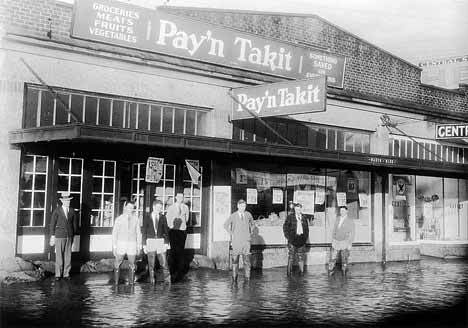Before the Howard Hanson Dam, the rainy winters of the Green River Valley brought with them a sense of dread.
The Green River, which created the fertile valley, frequently would become a flooding nemesis, turning the communities on its banks into unwelcome versions of Venice.
“If a flood was bad, the National Guard would send in the Army duck (amphibious vehicle) and sandbag the town stores and rescue the stranded residents,” remembers longtime Kent resident Eric Reitan, in a column for the Kent Reporter about his boyhood days living alongside the river.
By the 1920s, development in the Green River Valley had occurred to the point where officials determined something had to be done to stave off the river. In 1926 they formed the Associated Improvement Clubs of South King County, with one of their highest-priority aims being flood control.
This organized effort helped set the stage for what would eventually become a flood-control dam on the Green River.
The U.S. Army Corps of Engineers began studying the flood issues in 1936 and recommended a dam near Auburn. But it met with mixed response, partly because it blocked fish runs on the river. Flood control was put on the back burner for the corps at that point, due to the start of World War II.
The corps resumed its evaluation after the war, and in 1949, recommended building a flood-control dam at Eagle Gorge – the present site of today’s Howard Hanson Dam.
Congress approved funding, and for nearly the next decade, the corps began planning for the dam, with a groundbreaking Feb. 3, 1959. Construction of the earthen dam went on for three years, utilizing the skills of hundreds of workers. The project was formally dedicated May 12, 1962.
The structure is 675 feet in length, 960 feet thick at the base, and 23 feet thick at its crest. It cost $40.5 million to build, the lion’s share of that in federal dollars.
Originally called the Eagle Gorge Dam, the project was renamed by Congress in 1958 for the late Howard A. Hanson, a state legislator and Seattle attorney who was an impassioned advocate for the dam, and for the economic development he felt it would bring. Hanson died in 1957, before the dam was completed.
Hanson’s legacy lives on. With the dam successfully constructed, winter floods in the valley largely were a thing of the past. Development began to pick up, moving the valley out of its agrarian past and into the industrial era.
Today, the Green River Valley manufacturing district, running from Renton to Sumner, accounts for more than 80,000 jobs in the region and helps make the Puget Sound area the second-largest freight and wholesale distribution center on the West Coast, behind only the Los Angeles-Long Beach area, a fitting tribute to Hanson’s vision.
Information for this article was gleaned from historylink.org, a Web site describing itself as the “Free Online Encyclopedia of Washington State History.” To learn more, go to www.historylink.org
Talk to us
Please share your story tips by emailing editor@kentreporter.com.
To share your opinion for publication, submit a letter through our website https://www.kentreporter.com/submit-letter/. Include your name, address and daytime phone number. (We’ll only publish your name and hometown.) Please keep letters to 300 words or less.

